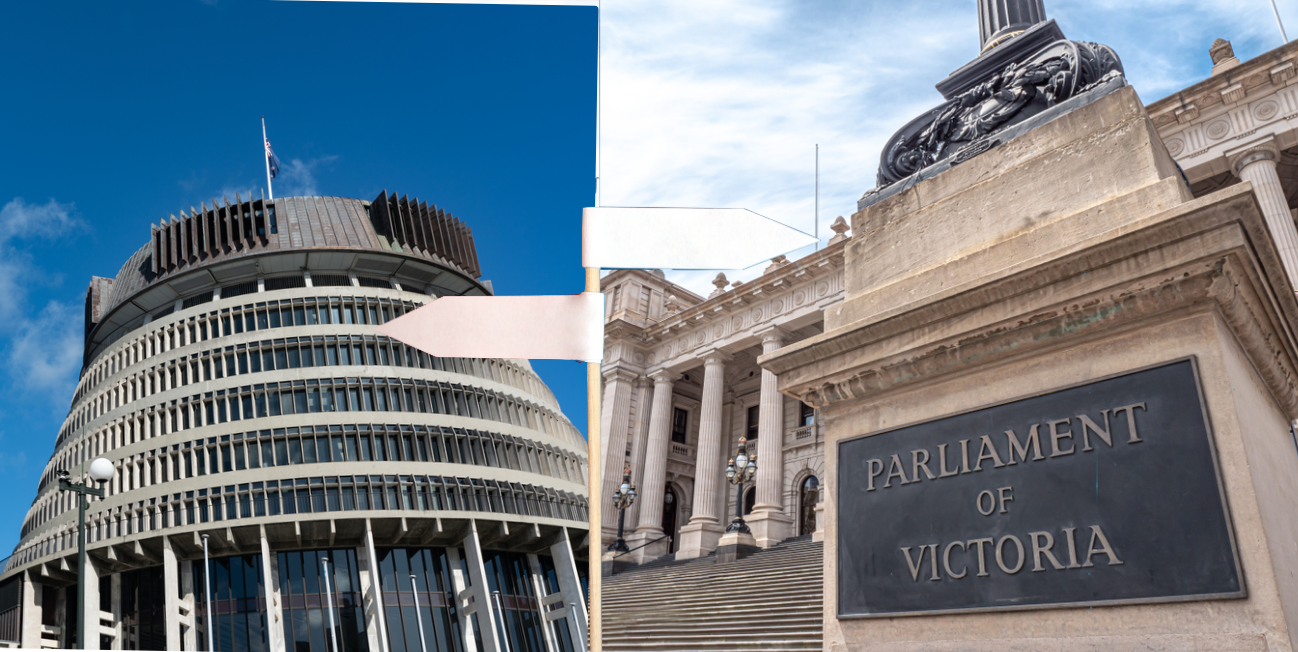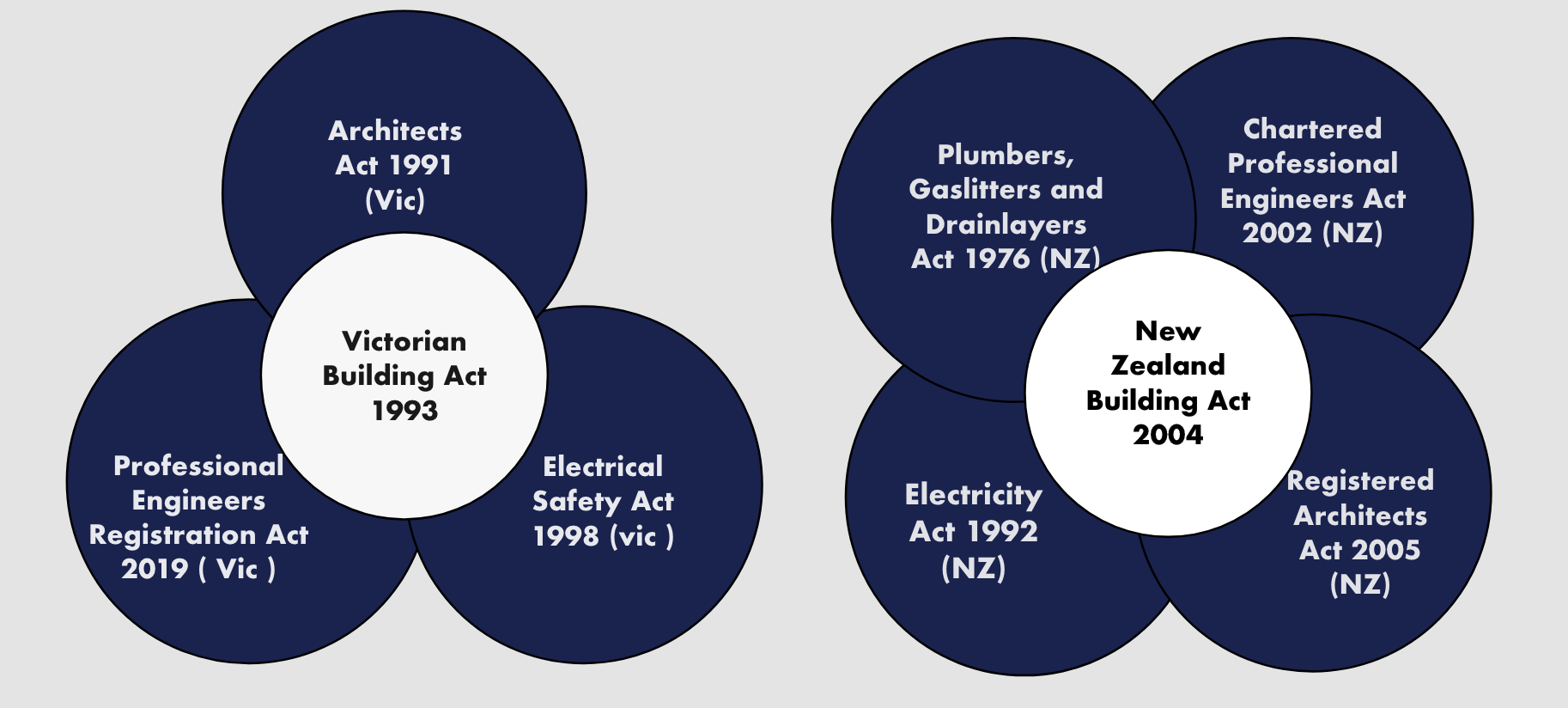
Introduction:
In this article we will look closely at the similarities and differences between the New Zealand Building Act 2004 (the New Zealand Act) and the Victorian Building Act 1993 (the Victorian Act). We will specifically examine three key areas beginning firstly with those whom are required to be registered/licenced within each jurisdiction.
We will then explore the liability limitation periods for the bringing of actions under the respective acts. We will then venture into the different insurance requirements under both statutes including domestic building insurance, professional indemnity insurance and public liability insurance
The Registrants:

The Victorian Act and its New Zealand counterpart specify different categories of registrants.
Victoria
In Victoria, one is required to be a registered builder if one works in domestic building and carries out contract works for more than $10,000.1 You do not have to register with the Victorian Building Authority (VBA) for jobs that involve only one of the following: plastering, tiling, electrical work, glazing, installing floor coverings, insulating, painting…2
There are categories of building practitioners in Victoria which the Victorian Building Authority (VBA) included in the definitions of ‘building practitioner’ under the Victorian Act. These categories are:
- building surveyors,
- building inspectors (unlimited/limited),
- quantity surveyors,
- building designer (building design – architectural, interior, services),
- commercial builders (unlimited/limited),
- domestic builders (unlimited/limited/manager),
- demolishers (low-rise buildings/medium-rise buildings/unlimited),
- erector or supervisor (temporary structures – Class 1 and 2),
- a project manager.3
It is worth noting, the Victorian Act also regulates plumbers in a similar manner to building practitioners by requiring under section 221D that plumbing work only be carried out by licenced or registered plumbers.4
New Zealand
In contrast, New Zealand’s emphasis differs in that it provides that all restricted building work (RBW) be carried out or supervised by a licenced building practitioner (LBP)’.5 Because RBW ‘is work that is critical to make a home structurally sound and weathertight’ there currently exists the following seven licensing classes:
- design,
- carpentry,
- roofing,
- brick and block laying,
- external plastering,
- foundations,
- site.6
The New Zealand system appears to place a heavier emphasis on specific trades or ‘sub-contractors’ as it were than Victoria. The term registered builder in Victoria is also found in the definitions section of the Building Act 1993.
In New Zealand, the categories attempt to capture all trades that perform restricted building work, such work is defined as ‘work that is critical to make a home structurally sound and weathertight’.7 So, at present the New Zealand Act seems limited to the capturing of tradespersons working on houses and small apartments. This is at odds with the current approach in Victoria which is a far broader church and is not merely corralled to homes but embraces far more complex and extensive building structures.
Of interest too is that the above mentioned ‘trades’, save for the design practitioners in the case of Victoria are sub-contractors in that they would typically be sub-contracted to the registered builder, particularly in the case of residential building work.

Residential building work in the case of both Victoria and New South Wales is governed by the Domestic Building Contracts Act 1995 (Vic) and the Home Building Act 1989 (NSW) respectively.
It is worth mentioning as it provides greater context that both jurisdictions operate in a wider ecosystem of legislation and regulations that are relevant to the building and construction industry.
The New Zealand framework contains the Registered Architects Act 2005, Chartered Professional Engineers Act 2002, Plumbers, Gasfitters, and Drainlayers Act 1976 and Electricity Act 1992 which provide registration/licensing requirements for architects, engineers, plumbers, gasfitters, drainlayers and electrical workers respectively.
Victoria is similar in how there is also a wider legislation base including the Professional Engineers Registration Act 2019, Electricity Safety Act 1998 and Architects Act 1991. These acts provide registration/licensing requirements for those specific participants. Victoria does however contain requirements for the registration of plumbers and acknowledges the category of building surveyors as a building practitioner under the Building Act itself.
Liability periods:

Under the New Zealand Act there is a 10-year limitation period which means civil proceedings in respect of building work cannot be brought after that period. This is stated in section 393(2) as:
‘…Civil proceedings relating to building work may not be brought against a person after 10 years or more from the date of the act or omission on which the proceedings are based.’8
Similarly, under the Victorian Act the liability period for non-cladding work is also 10 years under section 134(1) which states:
‘…a building action cannot be brought more than 10 years after the date of issue of the occupancy permit in respect of the building work (whether or not the occupancy permit is subsequently cancelled or varied) or, if an occupancy permit is not issued, the date of issue under Part 4 of the certificate of final inspection of the building work.’9
Unlike the New Zealand Act, Victoria provides an extension of five years for cladding work under section 134(2) as follows:
‘Despite subsection (1), a building action may be brought more than 10 years but less than 15 years after the date of issue of the occupancy permit in respect of the building work (whether or not the occupancy permit is subsequently cancelled or varied) or, if an occupancy permit is not issued, the date of issue under part 4 of the certificate of final inspection of the building work if:
(a) the building action is a cladding building action.’10
Although, you could be forgiven for believing the two liability limitation periods act in similar ways in practice, the New Zealand legislation is more problematic and troublesome. The New Zealand legislation is marred by uncertainty in terms of the time when the liability limitation period begins to run.
The Victorian legislation is not so marred as the liability period commencement trigger is crystal clear. However, as we see from New Zealand case law, in the decision of Wigglesworth v Auckland Council [2012] absent the Victorian specificity in this area, the terms ‘off-task’ or ‘off-duty’ were discussed as a test for considering when the commencement of the liability would run for a contractor.11
These phrases were used to define ‘when the ostensible 10-year period starts to run’ and would relate to situations where a ‘contractor stops work on the site, leaves the site and does not return’.12
The situation as when the liability period commences would not be so clear where ‘the sub-trader’s works are partially completed and then not finally completed until the end of the building project’ which is common.13
In any case, the vagueness of the New Zealand approach has been resolved in Victoria by the specificity of ’10 years from issuance of occupancy permit’.14 There is nothing that is either cryptic or uncertain about such a trigger. The OP is issued by the relevant building surveyor, a copy is kept with the council and 10 years post issue of the OP the ability to sue for economic loss is expunged (save for the cladding exemption).
Insurance Requirements:

The Victorian Act regulations contain very prescriptive requirements for registrants to possess insurance than compared to New Zealand. For example, in Victoria, if you undertake domestic building work worth more than $16,000 you need domestic building insurance.15
This specific power is contained in part 9 of the Victorian Act under section 135(1)(a) which gives the Minister the power to:
‘Require building practitioners in specified categories or classes of building practitioners or any part of a class or category of building practitioners or any persons in a specified category or class of engineers engaged in the building industry to be covered by insurance’.16
Aside from domestic building insurance, the Victorian jurisdiction also requires prescribed classes of registrants to have professional indemnity insurance.17 These apposite registrants are:
- building surveyors,
- building inspectors,
- quantity surveyors,
- civil, mechanical, electrical and fire safety engineers.
- building design (architectural), building design (interior), building design (services) draftsperson.18
Similarly, demolishers for low, medium and high-rise buildings and Class 1 & 2 erectors are required to have public liability insurance.19
In New Zealand the legislative power appears very similar to the Victorian Act under section 192 which allows the chief executive when:
‘Considering whether a person has adequate means to cover any civil liabilities’…’the chief executive may have regard to whether the person – holds an insurance policy that meets the minimum terms and conditions prescribed by regulations made under section 402(r)’.20
However, despite the similar powers of both jurisdictions to impose mandatory insurance requirements, New Zealand does not currently impose any mandatory insurance obligations for LBP’s.
Conclusion:
- Victoria uses the term ‘building practitioner’ whereas in New Zealand it is ‘licensed building practitioner’ (LBP).
- The differences are interesting and to a degree profound, as the Building Act registrants in Victoria are save for builders, typically degreed and are typically engaged by property owners.
- The NZ registrants in the Australian setting would be considered to be sub-contractors and tradespeople. Tradespersons in Victoria are not registered, save for plumbers. Further tradespeople are typically sub-contracted to builders in Victoria, regardless of whether they are residential, civil or commercial.
- Both jurisdictions offer a 10-year liability period albeit New Zealand’s liability commencement date is fraught with uncertainty which is leading to confusion when compared to the Victorian regime and resulting in litigation that could be avoided if the act was amended. Victoria also offers a 15-year liability period for works relating to cladding which New Zealand does not.
- Unlike Victoria, there are currently no mandatory insurance obligations visited upon building practitioners in New Zealand for licenced building practitioners (LBP’s), although whether professional indemnity cover would be available for the classes of New Zealand registrants is another question.
Some of our people
Kim Lovegrove has 4 adjunct/conjoint professorships is admitted to practice in New Zealand, is the Chairman of the IBQC and is a previous president of the NZIOB.
Kim has 30 years` experience in building regulatory law reform and has been a senior law reform consultant to the World Bank and state and national governments, in Australia, Asia and Africa.
Disclaimer
This article is not legal advice rather a discussion of the topic in only general terms. Should you be in
need of legal advice, please contact a construction law firm. Lovegrove & Cotton Lawyers and
our experienced team will assist you based on the facts and circumstances of your case.
Footnotes:
1 Victorian Building Authority, ‘Engaging a builder’ < Engaging a builder | Victorian Building Authority (vba.vic.gov.au)> <Accessed 10 April 2024>
2 Consumer Affairs Victoria, ‘Do you need to register?’ <Becoming a registered building practitioner – Consumer Affairs Victoria><Accessed 10 April 2024>
3 Victorian Building Authority, ‘Building Practitioner’ < Building practitioner registration | Victorian Building Authority (vba.vic.gov.au)><Accessed 10 April 2024>
4 Building Act 1993 (Vic) S 221D
5 Building Act 2004 (NZ) s 84
5 Licenced Building Practitioners, ‘Licensing Classes’<Licensing classes | Licensed Building Practitioners (lbp.govt.nz)><Accessed 10 April 2024>
6 Ibid
7 Ibid
8 Building Act 2004 (NZ) s 393
9 Building Act 1993 (Vic) s 134(1)
10 Building Act 1993 (Vic) s 134(2)-(a)
11 Wigglesworth v Auckland Council [2012] NZHC 1194
12 Presentation by Adjunct Professor Kim Lovegrove for the Society of Construction Law New Zealand, February 2023 <Kim-Lovegrove-NZ-SCL-Presentation-2023.pdf (lclawyers.com.au)><Accessed 16 April 2024>
13 Ibid
14 Ibid
15 Victorian Building Authority, ‘Insurance for building and plumbing work ‘< Engaging a builder | Victorian Building Authority (vba.vic.gov.au)> <Accessed 10 April 2024>
16 Building Act 1993 (Vic) s 135(a)
17 ‘Building Practitioners’ Insurance Ministerial Order’, Victorian Government Gazette, No. S 19 – 17 January 2020
18 ‘Building Practitioners’ Insurance Ministerial Order’, Victorian Government Gazette, No. S 19 – 17 January 2020
19 ‘Building Practitioners’ Insurance Ministerial Order’, Victorian Government Gazette, No. S 19 – 17 January 2020
20 Building Act 2004 (NZ) s 192 & 402(r)